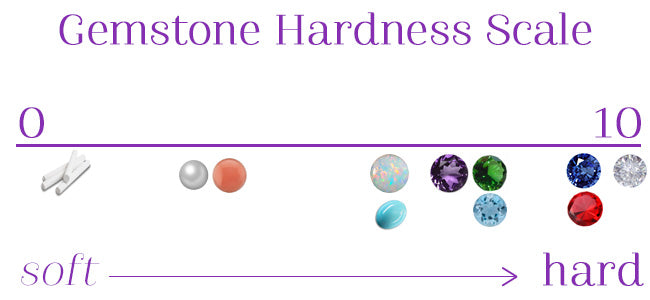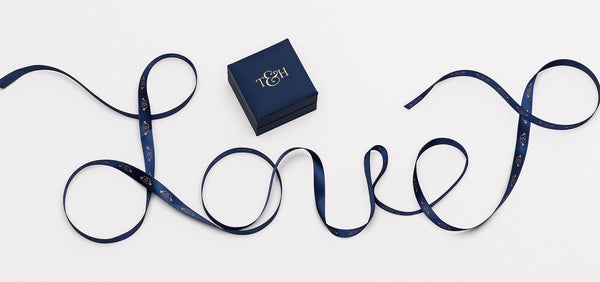With popularity for colored gemstones in engagement rings rising through the roof lately, we thought we'd put together a bit of information on gemstone hardness. While all gemstones are beautiful in their own unique ways, not all gemstones are created equal, structurally! Read on to find out all you need to know about gemstone hardness & which stone is right for your lifestyle. 

Pearls are known for their classic beauty and timeless elegance. They are also one of the softest stones out there, and are not recommended for someone who works with their hands a lot (like a doctor) because they can mar easily. There are a few different type of pearls, each varying in rarity & value — natural pearls, cultured pearls, saltwater pearls, freshwater pearls, and imitation pearls. Any respectable jewelry source (like Trumpet & Horn!) would be able to confidently determine if a pearl were an imitation.

Coral is a beautiful gemstone that originates from coral polyps in the ocean's depths. When coral dies, the remaining hardened skeleton can be polished into the gemstone that you so often see adorning fabulous jewelry. Coral can be white, pink, grey, or black, but is most traditionally thought of as an orange and red hue. In fact, the color "coral" gets its name from the orange redish color of the gemstone! In terms of hardness, coral is fairly delicate and should not be worn during vigorous activities.

Opal is different from most of the colored gemstones in the T&H Collection as it is not "technically" considered a mineral because it is primarily made up of anywhere between 3% and 30% water. Opals are extremely fragile because of this water content and those with higher water content also have a higher chance of breaking, meaning that a little extra care must be taken if you choose to wear a vintage opal ring! Most opals have what’s called "play-of-color", referring to the rainbow of colors that flash when an opal catches the light. This play of color occurs because of the way the silica spheres are stacked in an orderly fashion on top of each other. 97% of the world's opal supply comes from Australia, but they are also found in the United States, South America and Eastern Europe, among other places.

Turquoise means “Turkish Stone” because it entered Europe via a trade route through Turkey. It is an opaque stone that is bluish-green and commonly includes spots or veins of the host rock material called "matrix." Turquoise that does not contain any matrix is highly prized and can be extremely valuable. On the hardness scale, turquoise is relatively soft and can scratch easily. It’s also porous and can be discolored by oils from skin or lotions. Because it is porous, it is often treated with fillers like wax or resin to fill fissures and to stabilize the color. Turquoise is one of the oldest documented minerals to date. Ancient Egyptians, the Aztecs, Persian and Mesopotamian societies, and even ancient China all mined and used turquoise for adornment. There are many mines for turquoise in the United States, with Arizona being the most important producer. The most famous mine in Arizona is the Sleeping Beauty mine in Globe, AZ. However, the finest and most highly prized turquoise is Persian turquoise with an intense blue “robins egg” color that is free of any matrix.

Amethyst is the most highly valued gemstone in the quartz family. It ranges in color from a light lavender called “Rose de France” to a deep rich purple. It can also have a tinge of blue or red to its overall color as well. Amethyst is a fairly soft gemstone, and while it is generally thought of as great for everyday wear, it is still prone to scratches and dings. The word amethyst comes from ancient Greek and means “not drunken” since it is thought that wearing amethyst will protect the wearer from drunkenness. Amethyst has been used in jewelry throughout the centuries by the Egyptians, Greeks and medieval Europeans to name a few. It has also been a favorite gemstone of the Christian church and many amethysts have been used in religious jewelry. The most notable locations for amethyst are in Brazil, Madagascar, Russia and the United States. The Four Peaks mine in Arizona has produced highly desirable deep royal purple amethyst with a hint of red. Heating amethyst can change its color to green. These green quartz stones are called Prasiolite.

Emeralds are the most precious stone in the “beryl” family. The green color of emeralds is due to the presence of chrome in its chemical structure. Highly transparent, rich green emeralds are extremely rare and expensive. Emeralds are typically highly included (internally flawed) and only the very finest examples are transparent. Inclusions are not seen as faults in emeralds since the majority of stones are clouded this way. It is very common for most emeralds to be oiled in some way to hide fractures, and when disclosed to the buyer it is perfectly acceptable. However, oiling treatments are not very stable and care should be taken to keep the stones away from heat and ultrasonic jewelry cleaners. Emeralds are a fairly soft stone, and they are much more highly prone to scratches and breakage than diamonds, sapphires, and rubies. While you do need to be a bit more careful when wearing an emerald, if your vintage emerald engagement ring is cared for and worn properly, it will last several lifetimes!

Aquamarines are exactly the same as emeralds in terms of crystal structure, but the only difference is the chemical composition that makes aquamarines blue, and emeralds green! They are the same hardness scale Aquamarines are semi-precious stones, unlike most of the jewelry you see in our collection. The name "Aquamarine" was derived from an old Latin expression meaning "seawater", and rightly so, since these beautiful blue-green stones have an amazing glass-like luster to them. While they are most famous for the breathtaking medium sea blue color we've come to know (and love!) as "aquamarine", the gemstone can range in color anywhere from very light to dark blue with various levels of green. Aquamarines are exactly the same as emeralds in terms of crystal structure, but the only difference is the chemical composition that makes aquamarines blue, and emeralds green! These beautiful colored stones were typically used in war times (especially in the 1940's) because they were less expensive, and bigger stones actually exist without being outrageously expensive compared to their precious gemstone counterparts. While most aquamarines are mined in Brazil, they can be found all over the world in various countries like Mozambique, Kenya, Sri Lanka, Pakistan, Afghanistan, and Russia.

Sapphires are very hard and durable, making them a great stone to use for jewelry. Sapphires are a member of the “corundum” family and refer to all colors of corundum except red. When corundum is red, we call it a ruby (see below). Sapphires are typically thought of as blue, but they can actually be almost any color including pink, yellow, and green. Fine blue sapphires are the most valuable and are highly desirable, but sapphire vintage engagement rings can also be very affordable with a stone that is beautiful, but not considered rare. Most sapphires are heat treated to enhance their color - about 90% or more of all sapphires are heat treated. This treatment is stable, permanent, and when disclosed to the buyer, perfectly acceptable.

Like sapphires, rubies are very hard and durable, making them an excellent choice to wear in jewelry, and many vintage ruby rings can be fairly inexpensive compared to their diamond counterparts. Rubies are also a member of the “corundum” family and refer to all stones of this family that are red. The most desirable shade of ruby is called “pigeon’s blood”, which is pure red with just a hint of blue. An exceptional ruby that is very large is rare, and will often times be more expensive than a diamond. It is also common for rubies to be heat treated to enhance their color. This treatment is stable, permanent, and when disclosed to the buyer, perfectly acceptable.

Diamonds are the hardest of all the gemstones and extremely durable. In fact, diamonds are the hardest known substance, giving an entirely new meaning to the slogan "A diamond is forever"! Diamonds also have the best luster potential of all gemstones, meaning that they sparkle the most. A diamond's luster depends on the way in which it is cut. Modern stones are cut with lasers to optimize luster. We personally prefer antique stones that were cut by hand and sparkle best in romantic candlelight! The Four C's — Cut, Color, Clarity and Cart — all impact the price and value of a diamond. If you're someone who works with their hands a lot and is looking for a ring to last a lifetime (and then some!) a diamond is the way to go!

